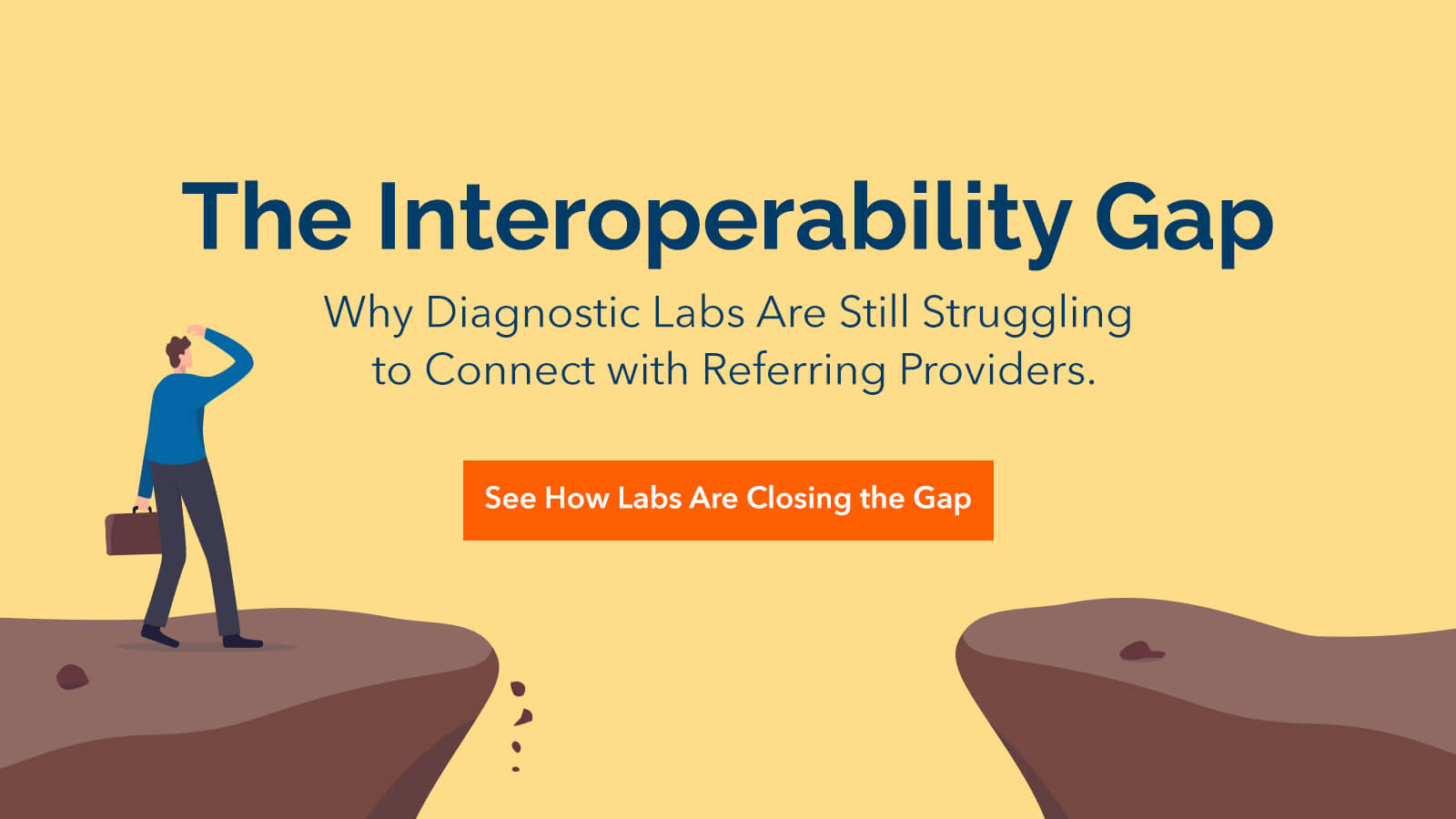The Interoperability Gap: Why Diagnostic Labs Are Still Struggling to Connect with Referring Providers
October 28, 2025 | Becca Gordon | Uncategorized

In an industry where precision and speed define both patient outcomes and business success, diagnostic laboratories continue to face a persistent and costly challenge: interoperability.
Despite decades of effort and billions of dollars invested in health IT, the data exchange between referring providers and independent clinical diagnostic labs remains fragmented, inefficient, and prone to errors.
The problem isn’t simply technical; it’s structural. Labs sit at the crossroads of care yet often lack direct integration with the myriad electronic health record (EHR) systems used by providers. Each provider relationship may require custom connectivity, unique interfaces, and manual processes that strain both operations and margins. For lab executives, this friction is more than an inconvenience; it’s a strategic threat.
The Complexity of Modern Referrals
Every lab knows the pain points:
- Inbound test orders arrive via fax or even printed requisitions.
- Patient demographics are incomplete or inconsistent.
- ICD-10® codes are missing.
- Insurance data is wrong or outdated.
The result: staff spend hours reconciling mismatched information or searching for missing data before a single specimen is processed. Alternatively, due to turnaround time pressure, they may process the specimen without the requisite data to prove clinical necessity and get paid for doing so.
On the provider side, clinicians are equally frustrated. Ordering tests via portal, fax, and paper:
- Interrupts patient care
- Introduces transcription risk
- Takes a burdensome amount of staff time and delays results
The result: many physicians simply avoid using labs that make ordering too cumbersome, resulting in lost revenue for labs and reduced patient choice.
The Patchwork of Integration Efforts
Over the years, labs have tried to fix interoperability through traditional HL7s, building beautiful portals, and trying to OCR faxes.
While HL7s are part of the toolkit that solves this problem and which may work for large hospital networks and high-volume referrers, they often fail to generate ROI for independent labs and smaller practices who may be using dozens of different EHRs. Each integration is complex, costly, and slow to deploy, creating frustration rather than collaboration in the relationship between the referrer and the lab.
Moreover, compliance and security requirements have grown stricter. Data must be exchanged safely, accurately, and transparently. Many smaller labs simply lack the IT infrastructure or bandwidth to manage hundreds of secure interfaces, version updates, and vendor certifications.
So far, the industry’s answer to this is for EHR vendors to provide marketplaces and application program interfaces (APIs), which place the burden and cost of integration and API maintenance on the backs of independent labs. One EHR vendor proudly advertises that they host more than 50 APIs!
This creates a paradox: the more digital the healthcare ecosystem becomes, the harder it can be for independent labs to stay connected.
The Business Impact
Operational inefficiency directly erodes profitability. Manual data entry and order reconciliation inflate labor costs, increase turnaround times, and heighten the risk of denied claims. When orders are incomplete or mismatched, billing delays and write-offs multiply.
From a customer experience perspective, poor interoperability diminishes provider satisfaction and loyalty. Referring physicians want the same seamless experience they get from major reference labs, but independents often can’t deliver it without draining their IT budgets. As a result, many labs lose business not because of quality or pricing, but because of workflow friction.
The Strategic Imperative
For today’s lab executive, solving interoperability is no longer optional, it’s existential. The future of diagnostics is driven by data liquidity . The ability to move, interpret, and act on information instantly and securely is critical. Labs that master this capability will position themselves as indispensable partners in care coordination and value-based medicine. Those that don’t risk being sidelined by larger networks with deeper integration capabilities.
The good news is that innovation in interoperability has finally reached a tipping point. Cloud-native technologies and secure automation frameworks are replacing the need for one-off interfaces. So, rather than building custom connections, labs can now use browser-based tools that connect securely to any provider’s EHR in real time, without requiring technical integration or data storage.
These solutions work within the clinician’s existing workflow, preserving compliance while eliminating manual re-entry and reducing onboarding time from months to minutes. For the lab, they deliver instant connectivity across provider networks, cleaner orders, faster reimbursements, and better experiences for everyone involved.
Looking Ahead
The labs that will thrive over the next decade are those that prioritize interoperability and treat it not as an IT burden, but as a growth engine. By embracing technologies that allow secure, real-time exchange of orders and results without the heavy lift of traditional integration they can reclaim control over their workflows, reduce operational drag, and build stronger, more scalable provider relationships.
The interoperability challenge has long been viewed as an unavoidable cost of doing business in healthcare. But it doesn’t have to be. A new model of digital connectivity is emerging, one that empowers labs to integrate instantly, securely, and compliantly with the providers they serve.
For forward-thinking lab leaders, the question is no longer if this transformation will happen, but how quickly they’ll move to lead it.
Article contributed by Becca Gordon, VP Sales and Marketing, Shadowbox
(323) 596-0999 | becca.gordon@shadowbox.com | shadowbox.com
Published by ADS RCM in their “LAByrinth” newsletter October 2025: Laboratory Billing Newsletter | October 2025 | Advanced Data Systems RCM

